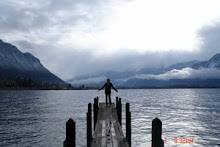Unfortunately Gaurav didn't follow us to Mumbai, and instead we had a new tour guide who made it his mission to show us everything he could in Mumbai in one day. This post is dedicated to some of the sightseeing highlights in Mumbai.
Dhobi Ghat
The first stop of the day was Dhobi Ghat, which is an outdoor washing ground in Mumbai. Dhobi Ghat is government sponsored and set up aside huge water pipelines. Hundreds of little bathtubs were along the pipeline, and clothes of every color were hanging everywhere. It almost looked like a festival was in town from all of the colors.

Doing laundry at Dhobi Ghat
Mani Bhavan
Next, we visited a museum named Mani Bhavan. In the early 1900s, Ghandi stayed in Mani Bhavan whenever he came to Mumbai. He played a substantial role in India's push for freedom, and many of his organized movements were led from this location.

Ghandi's room, where he lived and worked.
Jain Temple
Before going on this trip, I had thought Hinduism didn't have many sects, as Christianity does. I saw that I was wrong upon our visit to the Jain temple. Jain is a smaller sect of Hinduism, in part due to members being discouraged from marrying a non-Jain. As Monica explained, the Jain faith is a bit more strict. Whereas it is commonly known that most Hindus do not kill cows, the Jains do not believe in killing any living thing...even the microorganisms in the air. I noticed many followers wearing a small handkerchief around their mouths to prevent them from breathing in these microorganisms (and therefore killing them).
I also noticed that this temple had a slightly different offering system. Many worshippers brought the traditional flowers or bits of food to place at the base of various shrines, but a few people purchased small amounts of white and colored rice at the entrance of the temple. They used this rice to make designs either on the floor or on a small platform.

Using colored rice to make a tree design on the Jain temple floor.
The swastika, as shown below, was one of the most common symbols made with the rice. As I understood it, it is a symbol of one of the saints in the Jain tradition and is also an auspicious symbol or teaching tool that reminds us of a quality to lead us to enlightenment.

The swastikia: a holy symbol in Jainism and one of the most common symbols made on the rice boards.
Hanging Gardens of Mumbai
After visiting the Jain temple, we headed to the hanging gardens, which had an amazing view of the city.

Some school children that passed by us screaming "Welcome to India".
Elephanta Island
In order to get to our next stop, we took a ferry from the Gateway of India, which was built to celebrate the visit of King George V to Bombay. I'd imagine back then that it was the first thing that foreign visitors saw from their boat, as they were approaching the city.

Gateway of India
The ferry ride was about an hour to get to Elephanta Island, where there are temples carved into the island's caves. The name "Elephanta" comes from the large stone sculpture of an elephant found near the entrance by the Portugese explorers back in the day. It was a hot day, so the 120 huge stone steps to get to the island caves made for a nice workout :)

I just thought this was an awesome picture.


No comments:
Post a Comment